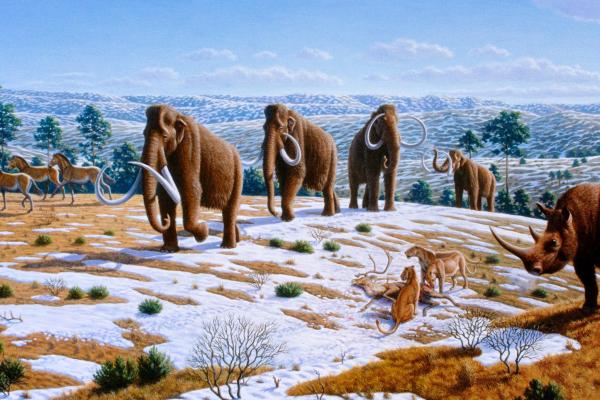
The landscapes of our planet looked very different 50,000 years ago when compared to today. This is due to various factors, including climactic conditions and the absence of human civilizations. For this reason, the plant and animal species that were present during prehistoric times also varied greatly. Some animals may resemble their prehistoric ancestors more closely than others, but many are now completely extinct for various evolutionary and environmental reasons. Many of these animals are considered megafauna.
As early humans began to develop as a species, many myths and legends appeared pertaining to their interactions. thedailyECO discovers the truth about these animals by providing a megafauna definition and examples of living and extinct animals.
What is megafauna?
The term megafauna depends on the context in which it is used. Mammologists use the term to refer to animals larger than 100 lb (45 kg), but other zoologists have used the threshold as high as over 1 metric ton (1,000 kg). When grouping benthic animals into types of fauna, megafauna can even be used to refer to animals such as crabs and scallops which are large relative to the bottom of the seafloor.
Geography is not the only important distinction used when describing megafauna. Period is also very important. It is for this reason megafauna are often referred to in terms of prehistoric animals. When referencing prehistoric megafauna, the specific era usually precedes the word.
Much scientific literature refers to animals from the late Pleistocene to the Holocene eras, from about 46,000 to 1,420 years ago. This period is important due to something known as the Quaternary extinction event. This is a period during which many animal species became extinct, the majority of which were considered megafauna. These changes were caused by climactic factors, but are also thought to be related to the growing Homeo sapiens population.
For this reason, we can provide a very general definition of megafauna as:
The large or giant animals of a given area during a particular period.
Many of the animals we consider megafauna are now extinct. Although there are evolutionary and climactic causes for this, human hunting of megafauna for food and other resources had a very significant impact. It is believed early humans overhunted these large beasts as they best suited their needs. Most current research suggests environmental and climactic changes weakened many of the species, with humans expediting their extinction[1].
When discussing megafauna, many still think of Pleistocene megafauna exclusively. As we can see with the below examples of megafauna, some still exist today[2].
Holmesin Giant Armadillo
These animals are from the genus Holmesina, an animal distantly related to the extant armadillo. Although there are animals today known as giant armadillos, these mammals were much larger as they could reach over 6.6' (2 meters) in length and weigh over 500 lb (227 kg). They were an omnivorous species, although they would have fed on insects. As with current armadillos, these animals had flexible plates which acted as armor against attack.

Mammoth
The genus Mammuthus belonged to the order as modern elephants and existed from the Pliocene to the Holocene era. As do elephants, they had a long proboscis, long tusks, a bulging head and, if they inhabited cold areas, thick fur that covered their entire body. They had very particular teeth as they had high molars and crests to avoid the wear and tear that their herbivorous diet could generate. This is still seen in elephants today.
The steppe mammoth (M. sungari) is the largest known mammoth species to exist, measuring over 13 feet in height at the withers. There were also smaller mammoth species such as the wooly mammoth (M. primigenius) which was barely 1 meter tall. All genera of mammoths went extinct, regardless of whether they were giants or not. They are different from the mastodon (Mammut) which are in the family Mammutidae.

Giant ground sloth
Also known as megatheres, giant ground sloths (Megatherium) are animals that could reach up to 20' in length. Unlike today's sloths that hang from trees, they were terrestrial. They fed by standing on two legs and used their huge nails to hold on to the trees from which they ate berries and other vegetation. They also used these nails to defend themselves or even to dig for edible tubers. This species of megafauna existed from the Pleistocene to the Holocene.

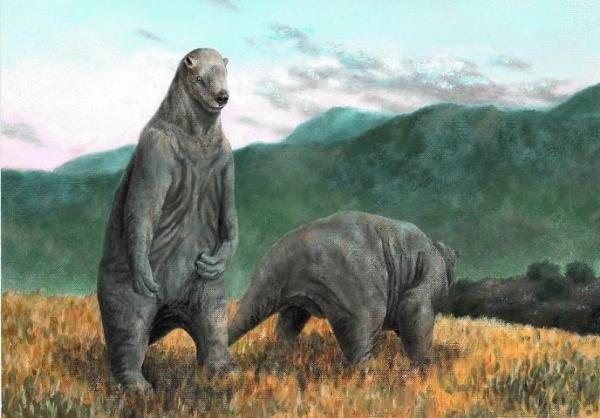
Gomphotheres
The gomphotheres (Gomphotheriidae) were proboscideans, making them relatives of living elephants and extinct mammoths. They had a very long face, but a relatively short probiscis. They had two pairs of tusks protruding from their mouths, with the lower ones sloping inward. Their appearance is reminiscent of a mix between a tapir and a wild boar. The reduced skull could accommodate fewer molars than other proboscideans. They could measure around 10' in height, around the same size as modern elephants.
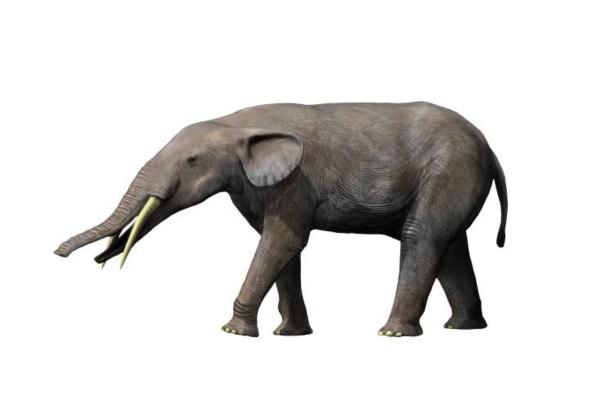
Marsupial lion
This big cat species weighed up to 350 lb and measured around 30" in height. Marsupial lions (Thylacoleo carnifex) were megafauna that existed during the Pleistocene epoch and became extinct 50,000 years ago. It was the largest carnivorous animal on the Australian continent. It had hunting skills just like today's cats, with silent attack strategies accompanied by attacks based on sharp claws and fangs.
Learn more about how our planet has developed over time by looking at our article on what is the Rodinia supercontinent?
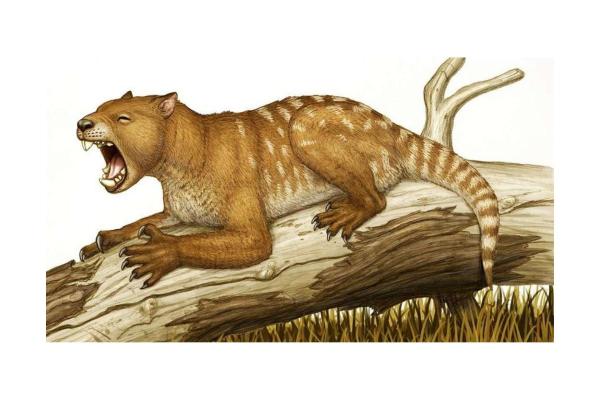
Cave bear
The cave bear (Ursus spelaeus) was larger than the Kodiak bear, the largest living bear species. It was 4.2' tall and 8.5' long. When standing on two legs, they could reach up to 10' in height. It weighed up to 1,500 lb and occupied a wide distribution range, covering practically all of Europe during the Pleistocene epoch. Its name is due to the fact that it inhabited caves, used to achieve its hibernation periods that it could share with prehistoric humans.
Learn more about this behavior by looking at the different types of hibernating animals.

Other examples of megafauna
In this section, we provide some of the extinct megafauna species which inhabited the Earth from prehistoric times:
- Megalodon (Carcharocles megalodon): shark that measured up to 65' in length and weighed over 50 tons, making them three times larger than the current great white shark.
- Aesop's swimming pig (Neochoerus aesopi): similar to capybaras, but weighed up to 375 lb. They lived in Mexico.
- Giant kangaroo (Procoptodon goliah): had the ability to raise their arms above themselves to tear branches from trees. They were 6.5' tall and had feet similar to horse hooves.
- Sabretooth (Smilodon populator): lived in South America, with a height of 4' and a weight of up to 880 lb. Its name alluded to its long teeth of up to 7.5'.
- Giant dragonfly (Meganeura): it was a dragonfly with a wingspan of 30', from wing to wing, which lived with the first insects during the Carboniferous period.
- Steller's sea cow (Hydrodamalis gigas): the largest sea cow that has ever existed at 32' long and weighing up to 10 tons. It managed to survive the Quaternary extinction event, but it was eliminated as soon as it was discovered in the 18th century by intense human hunting.
- Irish elk (Megalocerus giganteus): known as the giant moose, it had antlers of an impressive size up to11' from side to side. Their body was proportional, measuring approximately 6.5'.
- High Arctic camel (Paracamelus): inhabited the Arctic during global warming seasons, which did not have perpetual ice and was more of a forest. It measured 30% larger than current camels.
- Pelagornis (Pelagornis sandersi): they were seabirds from the Pleistocene, with a wingspan of 23' and which has positioned them as the largest birds that have ever existed.
Living megafauna
Some animal species managed to survive the mass extinctions of the Quaternary extinction event. Below we see examples of living megafauna that share our planet with us today:
African elephant (Loxodonta africana)
The African elephant is the largest land animal that exists, with a height of up to 13' and a weight of 5 tons. They are larger than Asian elephants and, like their extinct Proboscidean relatives, have a pair of distinctive tusks and long prehensile trunks with which they assist each other in a myriad of activities.
West Indian manatee (Trichechus manatus)
It is the largest manatee that survives. It can measure up to 15' with a weight of up to 1.5 tons. It is related to the extinct Steller's sea cow.
European bison (Bison bonasus)
It is the largest mammal in Europe. It is the result of hybridization between two extinct bison species, Bison priscus and Bos primigenius. It is for this reason it represents a bridge between prehistoric times and current animal species.
The last mass extinction was largely caused by humans. This should make us rethink our current role as unsustainable predators of natural resources. While megafauna still exist, we must begin to change our rampaging anthropogenic behavior to conserve the biodiversity that still exists and has intrinsic biological value.
Learn more about our impact on ecology by looking at our related article on the different types of environmental degradation.
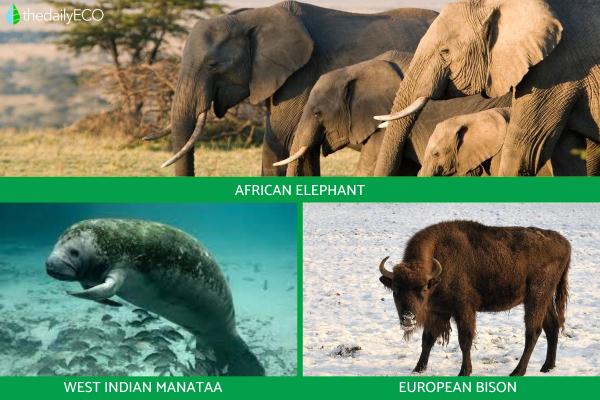
If you want to read similar articles to Megafauna Definition and Examples, we recommend you visit our Biodiversity category.
1. Pushkina, D., & Raia, P. (2008). Human influence on distribution and extinctions of the late Pleistocene Eurasian megafauna. Journal of human evolution, 54(6), 769–782. https://doi.org/10.1016/j.jhevol.2007.09.024
2. Malhi, Y., Doughty, C. E., Galetti, M., Smith, F. A., Svenning, J. C., & Terborgh, J. W. (2016). Megafauna and ecosystem function from the Pleistocene to the Anthropocene. Proceedings of the National Academy of Sciences of the United States of America, 113(4), 838–846.
https://doi.org/10.1073/pnas.1502540113
- Moleon, M., Sanchez-Zapata, J., Donazar, J., Revilla, E., Martín-López, B., & Gutiérrez-Cánovas, C. (2020). Rethinking megafauna. Proceedings of the Royal Society, 287(1922). https://royalsocietypublishing.org/doi/full/10.1098/rspb.2019.2643
- Days, R., & Eng, J. (2019). Capybaras in Mexico. Retrieved from: https://www.sabermas.umich.mx/secciones/articulos/496-capibaras-en-mexico.html
- Badillo, L. (2017). They relate extinction of megafauna in the Pleistocene to the presence of humans. The Science Day. Retrieved from:
https://ciencias.jornada.com.mx/2017/01/02/relacionan-extincion-de-megafauna-en-el-pleistoceno-a-presencia-de-humanos-6933.html - Europe Press. (2013). The Giant Camels of the Arctic. Retrieved from: https://www.elmundo.es/elmundo/2013/03/05/ciencia/1362502884.html